Alaska Economic Trends
Alaska Economic Trends is a monthly magazine that covers a range of economic topics.
Sign up for a free electronic subscription. 
Sign up for a paid print subscription.
Alaska Economic Trends are searchable from 1961 to the present using the Trends search page. The search can include any combination of the following: Key Words, Date Range, Author, Category
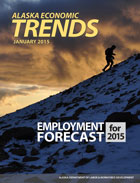
Alaska is not expected to gain jobs in 2015, as the state faces downward pressure from low oil prices and tightened government budgets. Net job growth is expected to be flat after an estimated 0.3 percent gain in 2014
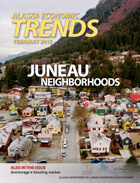
The City and Borough of Juneau covers 3,255 square miles, making it the largest state capital and the second-largest city in the nation by area, after Sitka. Most of that area is uninhabited, however, and Juneau's entire population of about 33,000 is distributed along a narrow sliver of coastal land between its namesake ice field and the waters of the Inside Passage.
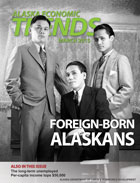
More than 60 percent of Alaskans were born outside the state - that's more than all other states except retiree-heavy Florida, Arizona, and Nevada. While many Alaskans were born elsewhere in the country, an increasing number were born outside the United States.

Alaska's population is in constant flux. Each year, thousands of Alaskans are born, thousands die, tens of thousands move to and from the state, and everyone who lives here ages. The most recent official estimates put Alaska's population at 735,601 in July 2014. That's a loss of just 61 people from July 2013, but it's notable because it was the first time in more than 25 years that Alaska's population declined.
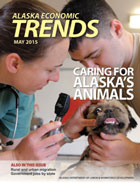
At first glance, animal care employment in Alaska looks a lot like it does in the rest of the country. With a similar mix of veterinarians, groomers, and pet store workers, it's a comparably small slice of Alaska's total job count. But Alaska often differs in what its animals need and what it takes to reach them.
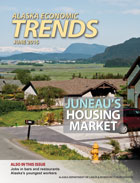
Juneau is full of historically and politically important homes. The National Register of Historic Places includes the governor's mansion, completed in 1912, the summer cabin of territorial governor Ernest Gruening at Amalga Harbor, built in 1947, and the Wickersham house, home of one of Alaska's most notable judges and statesmen, built in 1898.
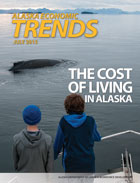
The cost of living in Alaska has been a topic of lore and fascination since the state's beginnings. During the gold rush days, writers lamented the often astronomical expense of goods in the territory compared to the rest of the nation - for example, a pound of canned butter during the Klondike Gold Rush was $5, or about $142 in today's dollars.
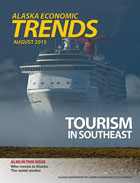
Tourism's rise in Southeast Alaska was tied primarily to the development of cruise lines, which helped the region's economies flourish and continue to transport the vast majority of Southeast's visitors. Today, around a million people visit Southeast Alaska each summer, and most arrive by cruise ship. Tourism was one of Alaska's first industries, and Southeast was the first visitor destination. During the late 19th century, small numbers of tourists traveled north on steamships, sharing space with miners, fishermen, and aspiring business owners in the new territory.
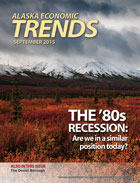
When crude oil prices slid precipitously in late 2014, many began to draw parallels between Alaska's current budget shortfall and the deep recession of the mid-1980s, questioning whether we're headed for another meltdown. The fiscal similarity between the two eras is clear: state general fund revenue is just as dependent on the value of oil now as it was then, and Alaska still relies heavily on federal spending. The relative importance of these two economic drivers hasn't diminished even as the rest of the economy has grown.
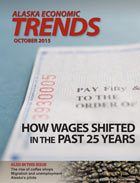
The number of workers in Alaska and the total amount earned has grown steadily over the past 25 years, but there have been shifts in the distribution of those earnings. The percentage of year-round workers making relatively low wages - between $20,000 and $40,000 - increased from 28 percent in 1989 to 34 percent in 2014. Conversely, the percentage making moderately high wages - between $70,000 and $150,000 - fell from 34 percent to 26 percent.
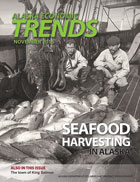
Alaska's commercial fishing employment grew by 0.7 percent in 2014, primarily driven by increased groundfish harvests. Groundfish harvesting employment grew by 24.8 percent, or about 350 jobs, with gains in every month of the year. Although 2014's total statewide increase was smaller than prior years, the industry has gained jobs every year since 2009.
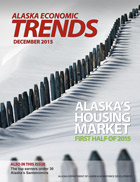
There's heightened interest in some of the state's broad economic measures recently as a result of low oil prices and state budget challenges. Through the first half of 2015, housing prices and other housing market indicators showed no major signs of weakness. The average sales price for a single-family home in Alaska increased 4 percent from the first half of 2014. But despite higher prices, housing affordability improved over that period. Statewide wages rose 3.5 percent, outpacing a 1.1 percent increase in inflation, and the average mortgage interest rate dropped a little over half a percentage point.
